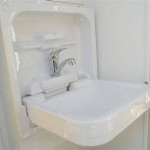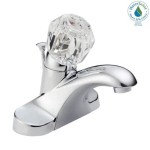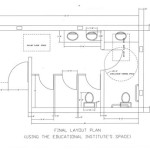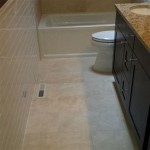Installing a Trap for a Bathroom Sink Drain: A Comprehensive Guide
The installation of a trap for a bathroom sink drain is a fundamental plumbing task that ensures proper drainage, prevents sewer gases from entering a residence, and contributes to the overall integrity of a plumbing system. Understanding the purpose of a trap, selecting the appropriate type, and following systematic installation procedures are crucial for a successful outcome. This article provides a detailed guide to installing a bathroom sink drain trap.
A trap, typically a P-trap or S-trap (though S-traps are often disallowed by modern plumbing codes), is a curved section of drainpipe designed to hold a small amount of water after each use. This retained water acts as a barrier, preventing noxious and potentially harmful sewer gases from rising up through the drain and into the bathroom. Without a properly functioning trap, these gases, which may include methane, hydrogen sulfide, and ammonia, can create unpleasant odors and pose health risks.
Before commencing the installation process, it is essential to gather the necessary tools and materials. These typically include a new P-trap kit (comprising the trap itself, tailpiece extensions, and slip nuts), pipe wrenches (adjustable or basin wrenches may be required), Teflon tape or pipe joint compound, a bucket, safety glasses, and work gloves. Having these items readily available will streamline the installation and minimize potential delays.
Key Point 1: Preparation and Removal of the Old Trap
The initial step involves preparing the workspace and removing the existing drain trap. This process necessitates careful execution to prevent water spillage and potential damage to surrounding fixtures.
First, position a bucket beneath the existing trap to catch any residual water that may be trapped within the system. Water often accumulates in the trap itself, as well as the drain lines leading to and from the trap. This precaution will prevent water damage to the vanity cabinet or flooring beneath the sink.
Next, carefully loosen the slip nuts that connect the trap to the tailpiece (the pipe extending down from the sink drain) and the drainpipe extending into the wall. Use a pipe wrench to loosen the nuts, turning them counterclockwise. In some cases, the nuts may be corroded or tightly secured, requiring the application of penetrating oil or gentle tapping with a hammer to facilitate loosening.
Once the slip nuts are sufficiently loose, carefully detach the old trap. Be prepared for a rush of water as the trap is disconnected. Thoroughly clean the tailpiece and drainpipe connections to remove any old sealant or debris. This ensures a clean and secure connection for the new trap.
Inspect the tailpiece and drainpipe for any signs of damage or corrosion. If damage is evident, these components may need to be replaced before proceeding with the trap installation. Ignoring damaged components can lead to leaks and future plumbing problems. Additionally, ensuring that the drainpipe extending from the wall is properly supported is crucial. If it is loose, securing it to a stud or other supporting structure will prevent strain on the new trap connections.
Key Point 2: Assembling and Installing the New P-Trap
After removing the old trap, the new P-trap must be assembled and installed. Proper alignment and secure connections are vital for a leak-proof and functional drain system.
Begin by assembling the P-trap components according to the manufacturer's instructions. Most P-trap kits include the trap itself, a tailpiece extension (if needed), and slip nuts with washers. Ensure that all components are clean and free of debris before assembly. Apply Teflon tape or pipe joint compound to the threads of the tailpiece and drainpipe connections. This sealant helps to create a watertight seal and prevents leaks.
Attach the tailpiece extension to the sink drain tailpiece, securing it with a slip nut and washer. Slide the slip nut and washer onto the tailpiece extension, ensuring that the washer is positioned correctly (usually with the beveled edge facing towards the nut). Tighten the slip nut by hand initially, then use a pipe wrench to tighten it further, but be careful not to overtighten, as this can damage the plastic components. The tailpiece extension may need to be cut to the proper length to align correctly with the P-trap inlet. Use a pipe cutter or fine-tooth saw to make a clean, straight cut. Deburr the cut end to ensure a smooth connection.
Connect the P-trap to the tailpiece extension and the drainpipe extending from the wall. Align the trap so that it sits directly below the tailpiece and lines up with the drainpipe. Secure the trap with slip nuts and washers, tightening them by hand initially, then using a pipe wrench for a final tightening. Again, avoid overtightening the nuts to prevent damage. Ensure that the trap is properly aligned and that the water seal is located below the drainpipe inlet. This is crucial for preventing sewer gases from entering the bathroom.
After connecting all components, carefully inspect all connections for proper alignment and tightness. Ensure that the trap is securely supported and not subject to unnecessary strain. Any misalignment or loose connections should be corrected before proceeding.
Key Point 3: Testing and Final Adjustments
The final step involves testing the newly installed P-trap for leaks and making any necessary adjustments to ensure proper drainage and a leak-free system.
Run water into the sink for several minutes, allowing it to fill the basin partially. Observe the connections around the trap and tailpiece for any signs of leaks. Carefully check the slip nuts and connections to the drainpipe. If any leaks are detected, tighten the slip nuts further or disassemble the connection and reapply Teflon tape or pipe joint compound. Ensure that the washers are correctly positioned and that the components are properly aligned.
While the water is running, also observe the rate of drainage. The water should drain freely and without any gurgling or unusual noises. If the drain is slow or if gurgling is present, it may indicate a partial blockage in the drainpipe. In such cases, try using a plunger to clear the blockage. If the plunging is ineffective, consider using a drain snake to remove any stubborn obstructions.
After testing for leaks and drainage, visually inspect the entire trap assembly for any signs of stress or misalignment. Ensure that the trap is properly supported and that there are no excessive bends or kinks in the connecting pipes. Any adjustments to the positioning or alignment of the trap should be made at this time. A properly installed and aligned trap will ensure optimal drainage and prevent future plumbing problems.
Once satisfied that the P-trap is leak-free and draining properly, thoroughly clean the work area. Remove any tools, materials, and debris. Wipe down the sink and vanity cabinet to remove any water or grime that may have accumulated during the installation process. Discard the old trap and any used materials in an appropriate manner.
In some instances, local plumbing codes may require a licensed plumber to perform or inspect drain trap installations. Before undertaking this project, consult local regulations to ensure compliance. Failure to adhere to local plumbing codes can result in fines or the need for corrective action.
The installation of a trap for a bathroom sink drain, while seemingly straightforward, requires meticulous attention to detail and adherence to established plumbing practices. Proper preparation, careful assembly, and thorough testing are essential for a successful and long-lasting installation. Regular inspection of the trap for leaks or signs of damage is also recommended to ensure the continued functionality of the drain system.

How To Install P Trap And Bathroom Sink Drain Piping Easy Installation For Beginners

Bathroom Sink Plumbing Installation Diy Montreal

How To Install The P Trap Under A Sink Dummies

Bathroom Sink Plumbing Installation Diy Montreal

How To Replace S Trap With A P Drain Plumbing Traps Work Air Actuated Valve Install

Replace A Trap And Add Cleanout Fine Homebuilding

How To Install A Pipe From Sink Drain Wall Ehow
How To Install Bathroom Sink Drain Queen Bee Of Honey Dos

How To Replace A Sink Stopper Quick And Simple Home Repair

How To Install A P Trap
Related Posts







